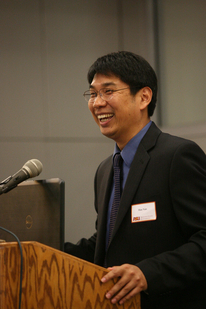Nov 2 2012
Scientific and medical research usually advances through the slow, painstaking accumulation of knowledge. Occasionally, however, radical ideas disrupt established patterns and may open up entirely new fields of study.
 Hao Yan holds the inaugural Milton D. Glick Distinguished Chair of Chemistry and Biochemistry. He is a researcher in the Center for Single-Molecule Biophysics at the Biodesign Institute. (Photo by: The Biodesign Institute at Arizona State University)
Hao Yan holds the inaugural Milton D. Glick Distinguished Chair of Chemistry and Biochemistry. He is a researcher in the Center for Single-Molecule Biophysics at the Biodesign Institute. (Photo by: The Biodesign Institute at Arizona State University)
Hao Yan, a researcher at Arizona State University’s Biodesign Institute, is working in one such domain. Known as theranostics, (a contraction of ‘therapy’ and ‘diagnostics’), the research represents a fresh approach to the diagnosis and treatment of disease, relying on nano-scale agents fabricated to carry out a range of functions in the body.
Yan and his collaborator Milan N. Stojanovic of Columbia University’s Department of Medicine are recent recipients of the 2012 Transformative Research Grant, an award specifically developed by the National Institutes of Health (NIH) to nurture unconventional, paradigm-shifting investigations. Established in 2009, the program is open to exceptional individuals and teams of investigators who propose path-breaking research in their chosen area.
According to NIH director Francis S. Collins, the Common Fund high-risk, high-reward program “provides opportunities for innovative investigators in any area of health research to take risks when the potential impact in biomedical and behavioral science is high." The award is so selective that a mere 20 projects were chosen this year to receive it, out of over 700 applicants.
Professor Yan is a specialist in nanoscale architectural forms and a pioneer in the field of DNA origami, a technique that capitalizes on the base-pairing properties of DNA nucleotides to construct elaborate and useful structures, some no larger than a virus particle.
In earlier research, Yan demonstrated the ability of DNA building blocks to create nanostructures resembling tiny baskets and bowls, spirals, spheres and Mobius shapes and even a spider-like entity capable crawling over a nanoscale trackway, guided in its movements by molecular cues.
A brilliant investigator (and one of the youngest researchers in the country to hold an endowed academic chair), Yan has extended the DNA origami method in significant ways, applying imaging techniques including Atomic Force Microscopy (AFM) to reveal a Lilliputian world of 2-D and 3-D nanostructures, many mimicking forms found in nature.
Under the new NIH award, Yan and Stojanovic will develop a range of theranostic nano-objects suitable for eventual in vivo diagnosis and therapy. In a scenario reminiscent of the sci-fi classic Fantastic Voyage, these futuristic intelligent agents will be designed to swarm through the bloodstream, carrying out imaging, diagnostic and therapeutic functions.
The theranostic nano-objects may be used to detect molecular early warning signals of disease – known as biomarkers – and report their status to a researcher or physician. They may also perform corrective operations by releasing various therapeutic agents or carrying out search-and-destroy maneuvers against aberrant cells.
Numerous applications exist for theranostic nano-objects and include the autonomous control of glucose levels in diabetes, the prevention of irreversible shock in intensive care patients and the selective elimination of narrow subpopulations of cells, as in the targeting of malignancy or infection.
To reach this new frontier of personalized disease diagnosis and treatment, Yan, Stojanovic and their colleagues will first seek to establish the basic science foundations and engineering principles underlying the use of the compact autonomous molecular devices under study.
Initial efforts will focus on methods to control the behavior of “neggs” (nano-eggs), made of deoxyribonucleic acids. The structures will contain sensors, imaging and/or therapeutic moieties, and molecular computing functions. Neggs are dynamic forms, capable of locking or unlocking upon receiving signals from their surrounding environment – for example, they may be triggered by the presence or absence of one or more biomarkers.
In the course of the new research, Yan and Stojanovic will demonstrate the transformative potential of theranostic nano-objects by engineering increasingly complex behaviors for neggs and mapping these to proof-of-concept therapeutic prototypes for which no existing technologies are satisfactory.
Some examples include opening a negg if an analyte rises above (e.g., glucose) or drops below (e.g., vasopressin) its “normal” concentration; marking for elimination/imaging narrow subpopulations of cells based on multiple surface markers, while protecting cells that differ in a single marker (e.g., on lymphocytes); and demonstrating amplification of MRI contrast agents on a targeted cell type (for example, ?-cells).
The new area of theranostics likely holds many surprises. Rapid developments in biology, chemistry, pharmacology, nanotechnology, imaging and medicine will expand the scope of research and eventually multiply the useful applications of this powerful approach. Theranostic systems may soon play a commanding role in the accurate monitoring of drug delivery, release and efficacy and for the pre-screening of patients for a range personalized medical interventions.
“We hope our interdisciplinary approach will lead to important new directions in theranostic applications,” Yan says. “This is a 5-year project and we need to work very hard now toward this goal.”